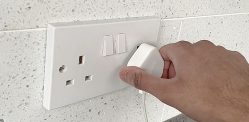you are still using energy.
With energy bills at an all-time high and as temperatures plummet, more households are looking at heating their homes whilst trying to save money.
One of the most common questions asked is whether it is cheaper to leave your heating on low all day or only use it when you need it.
Over the past year, households have seen their energy bills rise.
Under the Energy Price Guarantee (EPG), energy bills rose from around £1,200 in autumn 2021 to around £2,500 now.
From April 2023, the typical average household bill will rise to £3,000.
It is not known if energy bills will come down in 2023.
But, along with an increasingly cold winter, households might be left wondering what the cheapest way to heat their home is.
As of October 2022, the average prices for gas and electricity are as follows (according to Ofgem).
- 10.33p per kWh for gas
- 28.49p per day for gas standing charge (£103.98 per year)
- 34.04p per kWh for electricity
- 46.36p per day for electricity standing charge (£169.21 per year)
While there are options such as using oil-filled radiators, is leaving your heating on low all day cheaper?
Should you leave the heating on low all day?
Whether you have your heating on high or low, you are still using energy.
If you leave it on low all day, the cost will quickly add up and increase your energy bill.
Homes lose heat through windows, walls, doors and chimneys.
If you leave the heating on all day, not only will you be using more energy but more of it will be wasted.
But if your home is well insulated or you want to invest in insulation, you could conduct an experiment.
- First, take a meter reading. Then keep your heating on low all day for a week, taking another reading again at the end of the week.
- The following week, schedule your heating to come on twice a day. Again, take a reading at the end of the week.
You’ll be left with two different numbers to compare, which will give you an answer. However, this is also dependent on the weather.
That said, for most, switching the heating on only when you need will be the better option.
Keeping your home warm
Invest in Insulation
If you want to test out whether it’s cheaper to leave your heating on at a comfortable temperature, you’ll have to invest in insulation.
Around 25% of the heat from your house escapes through the roof.
Padding your loft could save you up to £130 a year. You can also install double or triple glazing on your windows.
Draught-proof your Home
As well as insulating, you could draught-proof your home – doing so could save you an extra £390 a year.
The government recently announced an insulation grant scheme which could see people get up to £15,000 to insulate their homes.
If you have a chimney, consider investing in a chimney sheep which costs around £60.
For £10 you could purchase draught tape for your windows, and for an additional £20, you can purchase draught excluders for your doors.
If you decide to get your home professionally draught-proofed, you’d be looking at a bill of £225 for an average three-bedroom home.
Install Heating Controls
If you don’t already have one, you could also install a thermostat and thermostatic radiator valves.
These allow you to control the temperature in your home, programme when the heating comes on and decide which rooms you want to heat.
According to the Energy Savings Trust, the cost for heating controls is around £580.
This could save up to £180 a year. Thermostatic radiator valves could save £55 a year.
When it comes to heating your home, it is important to heat it efficiently so that little is wasted as possible.
It is also important to keep an eye on how often you heat your home to ensure you don’t go over-budget when it comes to your energy bills.






























































